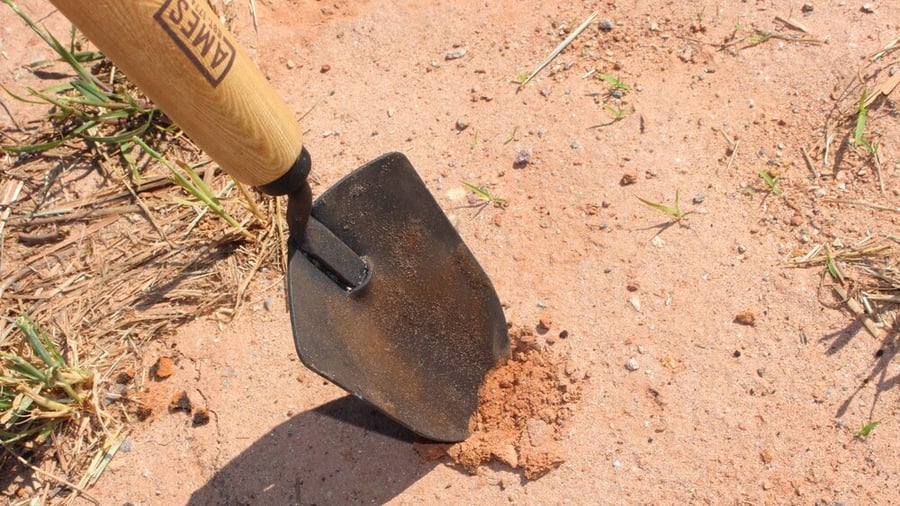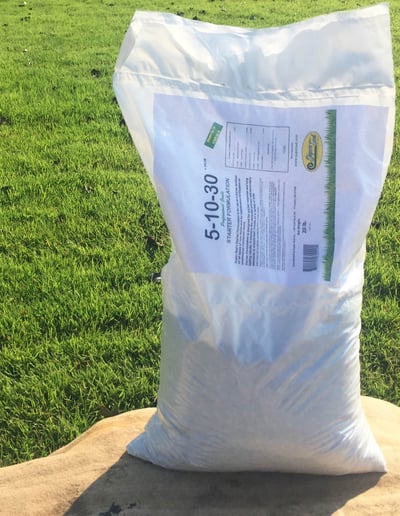

Why Lawn pH Matters — Testing & Adjusting Soil pH for a Healthy Yard

Lawn soil pH is often overlooked, but it plays an outsized role in the health of your turf. It determines whether your turfgrass can actually absorb the nutrients you add. Even if you feed your grass regularly, the wrong pH can block nutrient uptake, leaving the lawn weak, pale, or patchy. In this article, you’ll learn what lawn pH really is, why many Southeastern lawns start out too acidic, how many Southwestern lawns start out too alkaline, how fertilizing lawns affects acidity over time, how to adjust lawn pH using lime or elemental sulfur, and why soil testing is your first step.
For this post, we sat down with Ben Copeland Jr., Super-Sod CEO and self-proclaimed pH nerd, to discuss why lawn pH is so important.
Why Soil pH for Turfgrass Matters
You may remember learning about pH for the first time in elementary school and delving a little deeper into its meaning during high school or even college courses. Though most of us don’t discuss pH daily, it’s essential for human health and – as we’re talking about in this post – lawn health.
As you can see in the chart below, the soil pH affects nutrient uptake by turfgrass. That’s why we’re outlining the basics of pH and how it can affect your lawn.
Chart Columns: The blue bar marks the optimal pH range for nutrient uptake; however, nutrient uptake is often adequate at higher pH levels (you just need to watch for certain deficiencies).
Chart Rows: In each nutrient row, wider sections indicate strong availability, while narrower sections show reduced availability as pH shifts.
This chart illustrates how soil pH affects nutrient availability.
Chart by CoolKoon [CC BY 4.0], from Wikimedia Commons.
What Is Soil pH? (A Scientific Explanation)
pH is written with a lowercase p and a capital H because it’s a mathematical symbol that represents the logarithmic scale of hydrogen ions. The scale ranges from 0 to 14 with 0 being the most acidic, 7 indicating neutral, and 14 representing the most basic (alkaline).
If you’ll recall your chemistry classes, H is the symbol for hydrogen on the periodic table of elements with an atomic number of 1.
Since it’s a logarithmic scale, a substance that’s a 5.0 on the pH scale is 10x more acidic than one that’s a 6.0. But the difference becomes exponentially larger with each point. A 5.0 substance is 100x acidic than a 7.0 substance. That’s quite a range between 0 and 14!
Though hydrogen seems small as a measly atomic number of 1 on the periodic table, it makes a big impact. Think about the crash of the Hindenburg blimp and the hydrogen bomb. Both are significant in history and both completely dependent on hydrogen.
Hydrogen is just as significant in soil, so you shouldn’t be surprised that we take it so seriously!
Natural Soil pH Needs Fixing
If you live in the Southeast, we can almost guarantee that the pH of your clay or sandy soil is too acidic for a lawn. In the regions of Atlanta, Charlotte, or Raleigh the natural pH of clay soil is inherently acidic due to lack of organic matter, rainfall pH, and other inputs such as fertilizer.
Lawn soil acidity is especially threatening in residential areas with new home construction. Over the years, we’ve seen that backfilled soils at new homes often have a pH of 5. As we’ve learned, according to the logarithmic scale, that’s very acidic soil that needs to be amended.
If you live in the Southwest or West South Central region (Texas), you may have the opposite problem: soils formed from chalk or limestone are alkaline with a pH that's probably too high, around 7.5 to 7.8.
Don’t worry! We’re here to help you learn how to adjust your soil to an appropriate level and help your grass thrive.

Turfgrass pH Requirements
Just as with fertility levels, each type of grass has different soil pH preferences. Take a look at the chart below to determine what pH your grass prefers.
Optimal Soil pH for Lawns
|
Grass Type |
Ideal pH range |
|
Centipede* |
5.0 to 6.0 |
|
St. Augustine |
6.0 to 6.5 |
|
Bermuda |
6.0 to 7.0 |
|
Zoysia |
6.0 to 7.0 |
|
Elite Tall Fescue |
6.5 to 7.5 |
*Never apply lime or fertilizer to a TifBlair Centipede lawn without a soil test first. Centipede thrives in acidic soil with low nitrogen and can be severely damaged if fertilized unnecessarily.
Fertilizer Effects on Soil pH
A key way to ensure turfgrass success is to apply a chemical fertilizer, a typical blend of nitrogen, potassium, and phosphorus (N-P-K). While it provides nutrients to your lawn, this fertilizer blend actually makes your soil more acidic than it is naturally.
Acid Soil: Due to regular fertilization, you may need to add lime or compost to overcome the acidifying effects of N-P-K fertilizer. This means that adding lime and raising the pH isn’t a once-and-done activity. Even after you’ve raised your pH to a healthy level, one application of lime may be necessary for each application of fertilizer to counteract the acidifying effects of the N-P-K blend. Always apply lime based on the feedback from a soil test. Topdressing with compost is another way to neutralize the pH while building soil structure and adding slow-release nutrients.
Alkaline Soil: For alkaline soil, liming will only make the soil more alkaline, so do not apply lime when you fertilize. However, fertilizer could help lower the soil pH over time into a more favorable range. Other ways to lower the pH of alkaline soil is with elemental sulfur or organic matter like Soil³ compost.
Read more about improving your lawn soil with Soil³ compost: Prepare Your Lawn for Success with Compost.
Bonus: Lime adds Calcium and Magnesium
We know N-P-K fertilizer contains excellent nutrients for your lawn, but lime contains some essential elements for growth, too. Not only does it raise pH, but lime provides calcium and magnesium. In order of importance, here are the primary nutrients turfgrass needs:
- Nitrogen (N)
- Potassium (K)
- Calcium (Ca)
- Magnesium (Mg) & Phosphorus (P)
As you can see, calcium ranks 3rd in importance, while magnesium is just as important as phosphorus. By applying lime, you’re also supplying these additional “fertilizers” to your turfgrass.
Soil pH Test
The best way to measure your soil's pH is by conducting a pH soil test for your lawn where you collect some dirt in a bag and mail it to a lab for testing. We don't recommend the at-home testing units or digital meters because they aren't accurate.
By performing this pH soil test and reading your results, you can also determine if your lawn needs fertilizer and how much to add.
How to Correct Lawn Soil pH
⬆️ Raising Acidic Soil pH - Products
As mentioned above, clay and sandy soils in the Southeast are naturally acidic, so they often need liming based on the feedback from a soil test. (Note: Alkaline soils do not need lime to correct the pH, they need elemental sulfur or compost.)
- Lime: Once you get the results, it’s time to apply enough granular lime to your lawn to raise your acidic pH to an optimum level. The soil test report will let you know how much lime and fertilizer to apply per 1,000 square feet of lawn. A common rate is 6 pounds per 1,000 square feet.
- Compost: Compost has a neutral pH, so it helps bring native soil into balance and will raise the pH of acidic soils. When installing new sod, we recommend incorporating 1 cubic yard of Soil³ compost into the soil for every 2 pallets of sod (every 1,000 square feet). Every year thereafter, we recommend yearly compost topdressing to continue improving the soil from above.
⬆️ Raising Acidic Soil pH - Timing
Now, let's address the best timing or season to raise the pH of acidic soils, commonly found in clay and sandy soils.
New Sod: When starting a new lawn any time of year, incorporate granular lime into the soil before laying sod or planting seed. That way, the lime is present and lowering the pH as new roots spread into the amended soil. Learn more about preparing your soil before sod installation. Installation is also the ideal time to improve the soil with compost.
Established Warm-Season Sod: After your lawn has taken root, apply lime every year to keep the pH at a healthy level. Lime is slow to move and act in the soil. For this reason, it’s traditional to spread lime over warm-season lawns (Zoysia, Bermuda, St. Augustine) each year in the fall so it has time to take effect in the soil before spring greenup. However, lime can be safely spread on warm-season lawns at any time of year if a soil test reveals your lawn needs lime. Compost can be topdressed on warm-season lawns any month that they are actively growing, generally from March to August.
Special Notes:
- Centipede Lawns: Again, never apply lime or fertilizer to a new or established TifBlair Centipede lawn without a soil test first. Centipede thrives in acidic soil with low nitrogen and can be severely damaged if fertilized unnecessarily. Some Centipede lawns never require lime or fertilizer.
- Tall Fescue Lawns: A nearly neutral pH is especially critical for growing a healthy Tall Fescue lawn, so we recommend liming your lawn soil whenever you reseed or overseed Tall Fescue in the fall. However, it's also safe to spread lime on Tall Fescue any time of year, as needed. Compost should be topdressed on Tall Fescue during its active growth period, generally from September to April.
⬇️ Lowering Alkaline Soil pH - Products
As discussed in the beginning, soils made from chalk and limestone bedrock are naturally alkaline, so they often need elemental sulfur based on the feedback from a soil test. (Note: Acidic soils do not need sulfur to correct the pH, they need lime or compost.)
- Sulfur: Be careful not to overapply and apply only the recommended rate based on the feedback from a soil test report. Elemental sulfur lowers soil pH slowly as microbes convert it to sulfuric acid. Keep the soil moist to support the process. Apply on cooler days to reduce the risk of burning the lawn, but keep in mind that the microbes are most biologically active in warmer spring soils. It will take many months for this microbial process to occur and for the pH to slowly begin to lower.
- Compost: A gentle way to lower the pH of alkaline soil is with organic matter. Compost has a neutral pH, so it helps bring native soil into balance and will lower the pH of alkaline soils. When installing new sod, we recommend incorporating 1 cubic yard of Soil³ compost into the soil for every 2 pallets of sod (every 1,000 square feet). Every year thereafter, we recommend yearly compost topdressing to continue improving the soil from above.
- Pro Tip - Apply Iron: If you're seeing an iron deficiency, commonly called chlorosis, due to high pH soils, a quick and temporary fix is to spray liquid iron on your lawn, while you wait for the sulfur or compost to lower the pH. The iron will be absorbed through the grass leaves, and your lawn will turn darker green within weeks (sometimes regular and repeated iron applications are necessary if the soil pH remains too high).
⬇️ Lowering Alkaline Soil pH - Timing
Now, let's address the best timing or season to lower the pH of alkaline soils, which often occur in limestone- or chalk-based soils.
New Sod: When starting a new lawn any time of year, incorporate elemental sulfur into the soil before laying sod or planting seed. That way, the sulfur is present in the root zone to start lowering the pH when biological activity revs up during the right conditions as explained in the product section above. Learn more about preparing your soil before sod installation. Installation is also the ideal time to improve the soil with compost.
Established Warm-Season Sod: After your lawn has taken root, apply elemental sulfur every year in spring to keep the pH at a healthy level. Sulfur can be safely spread on warm-season lawns at any time of year if a soil test reveals your lawn needs the pH lowered.
Special Notes:
- Centipede Lawns: If your soil is alkaline, Centipede may never thrive and it might not be worth it to continuously spread sulfur to counteract an alkaline pH. Consider switching to Bermuda, Zoysia, and Tall Fescue lawns, which readily grow in near-neutral pH soils.
- Tall Fescue Lawns: A nearly neutral pH is especially critical for growing a healthy Tall Fescue lawn, so if you have a slightly alkaline soil, you may not need to adjust the pH. Even if the pH is optimal, we still recommend compost topdressing for Tall Fescue during its active growth period, generally from September to April.
Get Started Adjusting Soil pH
Now that you’re armed with a clear understanding of pH, we can’t wait to see you at our stores so you can pick up bags of lime. You can order ahead in our online store for pickup, or select delivery if you want it shipped.
Of course, we want to see you after you've taken your pH soil test for your lawn so you know how much to add to get it just right! We recommend a yearly soil test and using the results to guide how much fertilizer, lime, or sulfur you apply to your ground.
If you choose the compost route, you'll gently correct the soil pH while improving soil structure, adding microorganisms, and adding slow-release natural nutrients. We recommend an annual compost topdressing routine; note that this topdressing replaces one monthly fertilization, so you can skip fertilizing that month.
Elemental sulfur is available at most local garden centers. At this time, we don't carry it.
This piece was originally written by Allison Fortner in 2018 and revised by Hillary Thompson in 2025.








